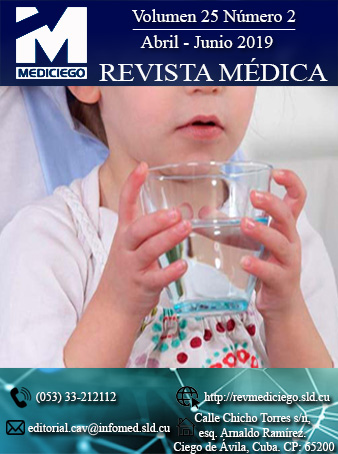Partial overdenture in older adult with bruxism
Abstract
Introduction: bruxism is a disorder that causes serious damage to the stomatognathic system, particularly the denture. Dental extraction causes progressive bony reabsorption of the residual alveolar rims, and this causes loss of retention and mismatches of dental prostheses. However, there are more conservative treatments that allow to keep the roots in the mouth and remaining teeth and guarantee the patient's adaptation to prostheses.
Objective: to present the case of an older adult patient diagnosed with eccentric bruxism, with great loss of dental substance, rehabilitated by using partial overlay denture as a valid option for oral rehabilitation.
Case presentation: a 70-year-old male patient with a history of hypertension, ischemic heart disease and type 2 diabetes mellitus. He was remitted from the basic stomatological services to the multidisciplinary prosthesis consultation of the Teaching Stomatological Clinic of Ciego de Ávila, to define the rehabilitation treatment appropriate to his case. Given the surgical risks presented, it was decided to preserve all the teeth in the mouth and perform pulporradicular treatments to support a removable partial overlay denture. Currently he carries his prosthesis in a satisfactory way and his quality of life has improved.
Conclusions: due to the considerable loss of dental substance caused by bruxism, the best option for this patient was conservative treatment and the use of a removable partial overlay denture. This allowed the patient to improve the quality of life and it was demonstrated that it is a valid option of oral rehabilitation in these cases.Downloads
Published
How to Cite
Issue
Section
License
Copyright (c) 2021 René Santana Delgado, Olga Liz Fernández González, Vivian Sahily Pérez Morales

This work is licensed under a Creative Commons Attribution-NonCommercial 4.0 International License.
Those authors who have publications with this journal accept the following terms of the License CC Attribution-NonCommercial 4.0 International (CC BY-NC 4.0):
You are free to:
- Share — copy and redistribute the material in any medium or format for any purpose, even commercially.
- Adapt — remix, transform, and build upon the material for any purpose, even commercially.
The licensor cannot revoke these freedoms as long as you follow the license terms.
Under the following terms:
- Attribution — You must give appropriate credit , provide a link to the license, and indicate if changes were made . You may do so in any reasonable manner, but not in any way that suggests the licensor endorses you or your use
- No additional restrictions — You may not apply legal terms or technological measures that legally restrict others from doing anything the license permits.
The journal is not responsible for the opinions and concepts expressed in the works, which are the exclusive responsibility of the authors. The Editor, with the assistance of the Editorial Committee, reserves the right to suggest or request advisable or necessary modifications. Original scientific works are accepted for publication, as are the results of research of interest that have not been published or sent to another journal for the same purpose.
The mention of trademarks of specific equipment, instruments or materials is for identification purposes, and there is no promotional commitment in relation to them, neither by the authors nor by the editor.






















